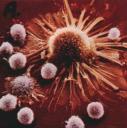Breast cancer is the most common cancer among women, except for non-melanoma skin cancers. The chance of developing breast cancer at some time in a woman’s life is about 1 in 7. About 70 percent of breast cancers occur in women who have no identifiable risk factors; 80 percent of all breast lumps are benign.
side Effects of the disease
Posted in Uncategorized on November 20, 2007 by amjad222Reduced Appetite
Sometimes decreased appetite is a problem.
If appetite decreases as the day progresses, make breakfast the big meal of the day. Don’t feel restricted to typical breakfast foods either. If you feel like eating a steak, baked potato and salad for breakfast, do it!
On the other hand, some people find eating five or six smaller meals a day works better than eating two or three larger meals.
Changes in Food’s Flavor
Cancer often affects the taste buds. Most commonly, it reduces the ability to taste sweetness. This changes the flavor of sweets, desserts, fruits and vegetables.
Use extra sugar with many desserts to improve the taste or to provide its accustomed taste. A teaspoon of sugar added to cooking water or glazing vegetables such as carrots may help improve vegetable flavors.
Some people experience an unusual dislike for certain foods, flavors or odors. This develops when unpleasant symptoms are tied to a food recently eaten.
Save your favorite foods for times when you feel well. Try not to eat one to two hours before treatment or therapy. If you no longer enjoy beef or pork, you may find chicken, fish, eggs, milk products or legumes more appealing. Marinate meats or cook them with sauces or tomatoes to help improve the flavor. Meats that are cold or at room temperature may be more palatable.
A third potential taste change is an increased liking for tart flavors. Adding lemon juice to foods may make them taste better. A cancer patient may enjoy grapefruit, cranberry or other tart juices.
Posted in Uncategorized on November 14, 2007 by amjad222
 Results of a new study find that men who are diagnosed with prostate cancer have a greater risk of death if they are overweight or obese.
Results of a new study find that men who are diagnosed with prostate cancer have a greater risk of death if they are overweight or obese.
The study found that men with a body mass index (BMI) higher than 25% at time of prostate cancer diagnosis, were almost 2 times more likely to die from their disease than thinner men.
In the study performed by researchers at Massachusetts General Hospital they followed a total of 788 patients with locally advanced prostate cancer for 8 years. This allowed them to realize that those men whose BMIs were between 25 and 30 % were 1.5 times at greater risk of dying from their disease.
type of cancer
Posted in Uncategorized on November 7, 2007 by amjad222adrenal cancer:
the adrenal glans its just small gland located on each of your kidneys
the most common tumer of the adrenal gland is actually a benign tumor calles an adrenal adenoma,these tumor never cause a patient to have any symptoms and do not need to treat,adrenal adenoma actually come from cancer cells that have spread from other parts of the body to the adrenal gland,there is another kind of tumor is cortical cancer it’s usually occur in patients between the ages of 30 and 50 until now it is not known what causes adrenal cortical cancer,usually the signs of both adrenal adenoma and cortical tumors can be produce more steroid hormones.
rectal cancer:
the rectal is part of the body’s gastrointestinal system,the rectum is the last several inches of the large intestine.
these cancer often in men and women over the age of 50
chemotherapy:using chemicals to treat cancer
Posted in Uncategorized on November 6, 2007 by amjad222chemotherapy,the use of medication to treat cancer,years of testing and research have proved chemotherapy to be an effective cancer treatment
Depending on what type of cancer you have and whether it has spread, your doctor may use chemotherapy to:
- Eliminate all cancer cells in your body, even when cancer is widespread
- Prolong your life by controlling cancer growth and spread
- Relieve symptoms and enhance your quality of life
| Watch for signs of infection | ||||||||||||||||||||||||
| Be sure to report any of the following signs of infection immediately to your doctor: | ||||||||||||||||||||||||
|
| What is Neulasta®? |
| Neulasta® is a prescription medication called a white cell booster that helps your body produce more white blood cells to reduce your risk of infection. A low white blood cell count can delay your chemotherapy or keep you from getting your full dose. |
| At every step of your chemo, it’s important to help protect yourself against infections. Taking a white cell booster such as Neulasta® (pegfilgrastim) is one way to protect yourself, but there are other everyday precautions that are also helpful, such as the following: | ||||||||||||||||||||||||||||||||||||
|
||||||||||||||||||||||||||||||||||||


